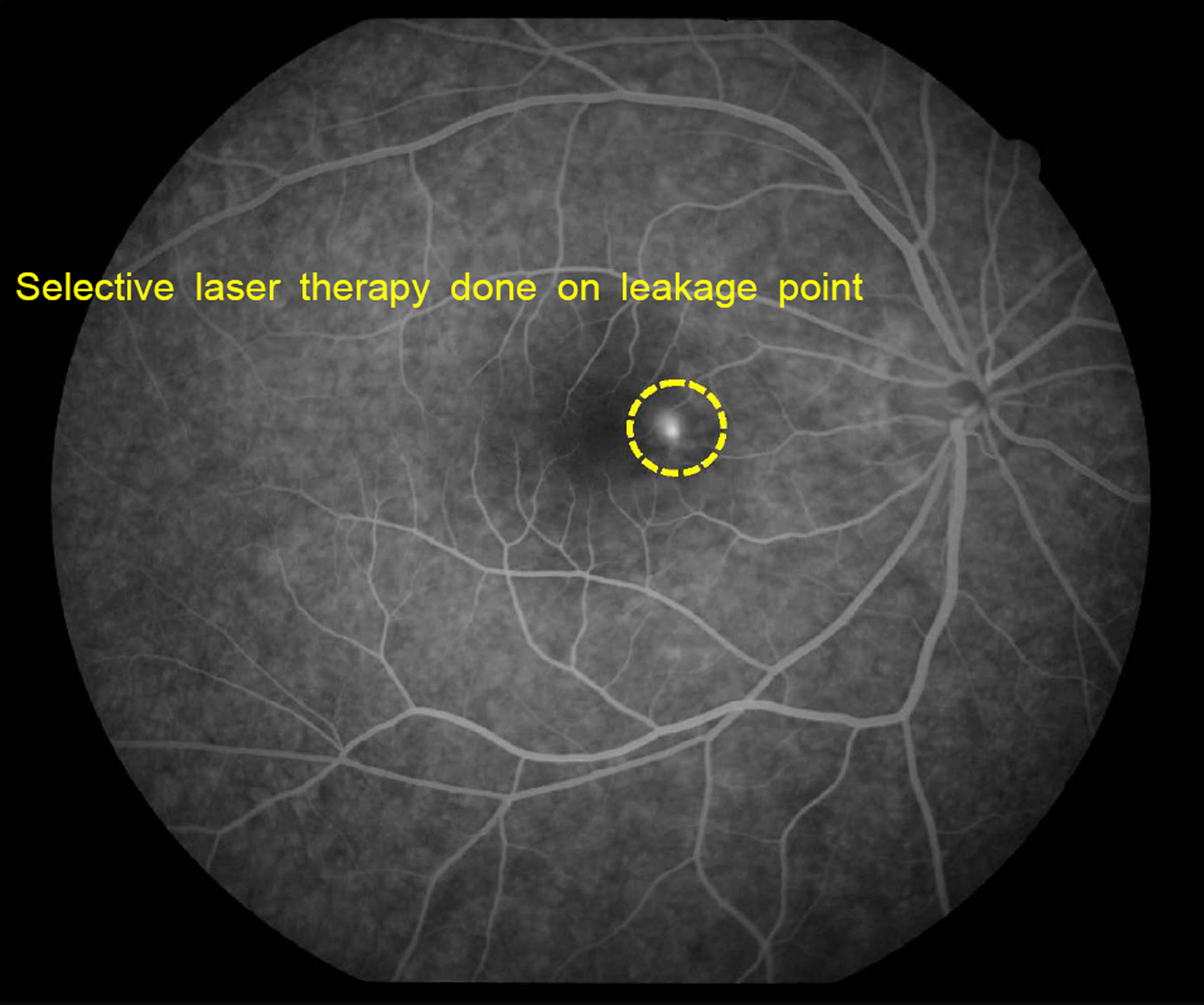J Korean Ophthalmol Soc.
2018 Oct;59(10):915-921. 10.3341/jkos.2018.59.10.915.
Selective Retina Therapy in Patients with Central Serous Chorioretinopathy
- Affiliations
-
- 1Myung-Gok Eye Resarch Institute, Department of Ophthalmology, Kim's Eye Hospital, Konyang University College of Medicine, Seoul, Korea. redmanson@kimeye.com
- KMID: 2422579
- DOI: http://doi.org/10.3341/jkos.2018.59.10.915
Abstract
- PURPOSE
We evaluated the visual outcomes and changes in central macular thickness in patients with central serous chorioretinopathy who underwent selective retina therapy.
METHODS
Patients diagnosed with central serous chorioretinopathy were included in the study. Fundus fluorescein angiography was performed before laser treatment. We reviewed the charts of 16 patients (17 eyes) in terms of age, sex, best-corrected visual acuity, intraocular pressure, slit lamp examination, the time from diagnosis to laser treatment, the site of laser treatment and side-effects. Optical coherence tomography was performed before laser treatment and 1 month later; the central macular thicknesses were compared.
RESULTS
The average best-corrected visual acuity at diagnosis and 1 month after laser treatment were 0.20 and 0.12 (logMAR) respectively. The improvement was thus 0.08 (logMAR). The average central macular thickness decreased by 174.78 µm from 326.53 ± 59 µm at baseline to 151.75 ± 15 μm 1 month after selective retina therapy.
CONCLUSIONS
Selective laser therapy afforded favorable visual and structural outcomes and was not associated with a risk of scotoma or other untreatable side-effects.
Keyword
MeSH Terms
Figure
Reference
-
References
1. Fujita K, Shinoda K, Matsumoto CS. . Microperimetric evalua-tion of chronic central serous chorioretinopathy after half-dose photodynamic therapy. Clin Ophthalmol. 2012; 6:1681–7.2. Wang M, Munch IC, Hasler PW. . Central serous chorioretinopathy. Acta Ophthalmol. 2008; 86:126–45.
Article3. Oh J, Kwon OW, Kim MH. . Photodynamic therapy for chronic central serous chorioretinopathy: multicenter study of 65 cases. J Korean Ophthalmol Soc. 2009; 50:390–8.4. Gass JD. Pathogenesis of disciform detachment of the neuroepithelium. Am J Ophthalmol. 1967; 63((Suppl 1)):1–139.5. Yannuzzi LA, Shakin JL, Fisher YL, Altomonte MA. Peripheral retinal detachments and retinal pigment epithelial atrophic tracts secondary to central serous pigment epitheliopathy. Ophthalmology. 1984; 91:1554–72.
Article6. Yannuzzi LA, Slakter JS, Gross NE. . Indocyanine green an-giography-guided photodynamic therapy for treatment of chronic central serous chorioretinopathy: a pilot study. Retina. 2003; 23:288–98.7. Hee MR, Puliafito CA, Wong C. . Optical coherence tomog-raphy of central serous chorioretinopathy. Am J Ophthalmol. 1995; 120:65–74.
Article8. Montero JA, Ruiz-Moreno JM. Optical coherence tomography characterisation of idiopathic central serous chorioretionpathy. Br J Ophthalmol. 2005; 89:562–4.9. Spitznas M. Pathogenesis of central serous retinopathy: a new working hypothesis. Graefes Arch Clin Exp Ophthalmol. 1986; 224:321–4.
Article10. Spaide RF, Goldbaum M, Wong DW. . Serous detachment of the retina. Retina. 2003; 23:820–46.
Article11. Yannuzzi LA. Central serous chorioretinopathy: a personal perspective. Am J Ophthalmol. 2010; 149:361–3.
Article12. Quin G, Liew G, Ho IV. . Diagnosis and interventions for cen-tral serous chorioretinopathy: review and update. Clin Exp Ophthalmol. 2013; 41:187–200.
Article13. Wood EH, Karth PA, Sanislo SR. . Nondamaging retial laser therapy for treatment of central serous chorioretinopathy: what is the evidence? Retina. 2017; 37:1021–33.14. Roider J, Brinkmann R, Wirbelauer C. . Retinal sparing by se-lective retinal pigment epithelial photocoagulation. Arch Ophthalmol. 1999; 117:1028–34.
Article15. Brinkmann R, Roider J, Birngruber R. Selective retina therapy (SRT): a review on methods, techniques, preclinical and first clin-ical results. Bull Soc Belge Ophtalmol. 2006; 302:51–69.16. Roider J, Liew SH, Klatt C. . Selective retina therapy (SRT) for clinically significant diabetic macular edema. Graefes Arch Clin Exp Ophthalmol. 2010; 248:1263–72.
Article17. Piccolino F, Eandi CM, Ventre L. . Photodynamic therapy for chronic central serous chorioretinopathy. Retina. 2003; 23:752–63.
Article18. Scholz P, Altay L, Fauser S. Comparison of subthreshold micro-pulse laser (577 nm) treatment and half-dose photodynamic therapy in patients with chronic central serous chorioretinopathy. Eye (Lond). 2016; 30:1371–7.19. Kang S, Park YG, Kim JR. . Selective retina therapy in patients with chronic central serous chorioretinopathy: a pilot study. Medicine (Baltimore). 2016; 95:e2524.20. Klatt C, Saeger M, Oppermann T. . Selective retina therapy for acute central serous chorioretinopathy. Br J Ophthalmol. 2011; 95:83–8.
Article21. Brinkmann R, Roider J, Birngruber R. Selective retina ther-apy(SRT): a review on methods, techniques, preclinical and first clinical results. Bull Soc Belge Ophtalmol. 2006; 302:51–69.22. Elsner H, Pörksen E, Klatt C. . Selective retina therapy in pa-tients with chronic central serous chorioretinopathy. Graefes Arch Clin Exp Ophthalmol. 2006; 244:1638–45.23. Ross A, Ross AH, Mohamed Q. Review and update of central se-rous chorioretinopathy. Curr Opin Ophthalmol. 2011; 22:166–73.
Article24. Framme C, Walter A, Berger L. . Selective retina therapy in acute and chronic-recurrent central serous chorioretinopathy. Ophthalmologica. 2015; 234:177–88.
Article
- Full Text Links
- Actions
-
Cited
- CITED
-
- Close
- Share
- Similar articles
-
- A Case of Central Serous Chorioretinopathy Following Systemic Corticosteroid Therapy
- A case of Atypical Central Serous Chorioretinopathy with Bullous Retinal Detachment
- A Seasonal Variation of Central Serous Chorioretinopathy
- Stellate Ganglion Block for Treatment of Central Serous Chorioretinopathy
- Measurement and Analysis of Neurosensory Retinal Detachment in Central Serous Chorioretinopathy Using Heidelberg Retina Tomograph




